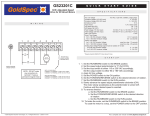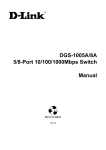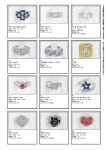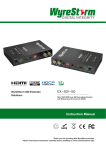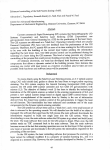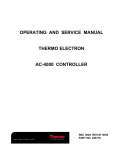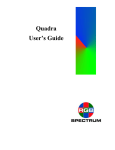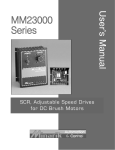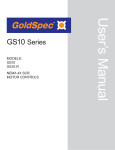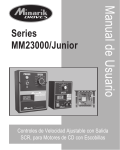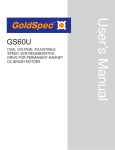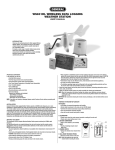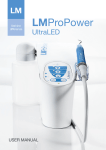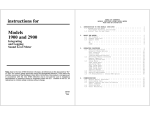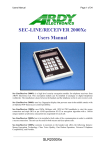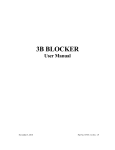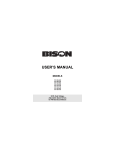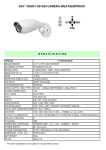Download User Manual - Applied Industrial Technologies
Transcript
SCR, Adjustable Speed Drives for DC Brush Motors User’s Manual GS23000C Series Contents Safety Warnings denotes an important safety tip or warning. • This symbol Please read these instructions carefully before performing any of the procedures contained in this manual. • DO NOT INSTALL, REMOVE, OR REWIRE THIS EQUIPMENT WITH POWER APPLIED. Have a qualified electrical technician install, adjust and service this equipment. Follow the National Electrical Code and all other applicable electrical and safety codes, including the provisions of the Occupational Safety and Health Act (OSHA), when installing equipment. • Reduce the chance of an electrical fire, shock, or explosion by proper grounding, over-current protection, thermal protection, and enclosure. Follow sound maintenance procedures. It is possible for a drive to run at full speed as a result of a component failure. Manufacturer strongly recommends the installation of a master switch in the main power input to stop the drive in an emergency. Circuit potentials are at 115 VAC or 230 VAC above earth ground. Avoid direct contact with the printed circuit board or with circuit elements to prevent the risk of serious injury or fatality. Use a non-metallic screwdriver for adjusting the calibration trimpots. Use approved personal protective equipment and insulated tools if working on this drive with power applied. 2 Safety Warnings . . . . . . . . . . . . . . . . . . . . . . . . . . . . . . . . . . . . . . . . . . 2 Specifications . . . . . . . . . . . . . . . . . . . . . . . . . . . . . . . . . . . . . . . . . . . . 3 Dimension . . . . . . . . . . . . . . . . . . . . . . . . . . . . . . . . . . . . . . . . . . . . . . . 4 Installation . . . . . . . . . . . . . . . . . . . . . . . . . . . . . . . . . . . . . . . . . . . . . . . 5 Chassis drives . . . . . . . . . . . . . . . . . . . . . . . . . . . . . . . . . . . . . . . . . . . 6 Mounting . . . . . . . . . . . . . . . . . . . . . . . . . . . . . . . . . . . . . . . . . . . . . 5 Wiring . . . . . . . . . . . . . . . . . . . . . . . . . . . . . . . . . . . . . . . . . . . . . . . . 5 Shielding guidelines . . . . . . . . . . . . . . . . . . . . . . . . . . . . . . . . . . . . . 5 Heat sinking . . . . . . . . . . . . . . . . . . . . . . . . . . . . . . . . . . . . . . . . . . . 5 Speed adjust potentiometer . . . . . . . . . . . . . . . . . . . . . . . . . . . . . . . 5 Chassis drive connections . . . . . . . . . . . . . . . . . . . . . . . . . . . . . . . . 6 Power, fuse and motor connections . . . . . . . . . . . . . . . . . . . . . . . . . 6 Voltage follower . . . . . . . . . . . . . . . . . . . . . . . . . . . . . . . . . . . . . . . . 7 Cased drives . . . . . . . . . . . . . . . . . . . . . . . . . . . . . . . . . . . . . . . . . . . . 7 Mounting (NEMA 1 enclosures) . . . . . . . . . . . . . . . . . . . . . . . . . . . . 7 Heat sinking . . . . . . . . . . . . . . . . . . . . . . . . . . . . . . . . . . . . . . . . . . . 7 Line fusing . . . . . . . . . . . . . . . . . . . . . . . . . . . . . . . . . . . . . . . . . . . . 7 Connections . . . . . . . . . . . . . . . . . . . . . . . . . . . . . . . . . . . . . . . . . . . 7 Current limit LED (C models only) . . . . . . . . . . . . . . . . . . . . . . . . . . . . 8 Meter header block (cased C models only) . . . . . . . . . . . . . . . . . . . . . 8 Operation . . . . . . . . . . . . . . . . . . . . . . . . . . . . . . . . . . . . . . . . . . . . . . . . 8 Before applying power . . . . . . . . . . . . . . . . . . . . . . . . . . . . . . . . . . . . . 8 Voltage select switches . . . . . . . . . . . . . . . . . . . . . . . . . . . . . . . . . . . . 8 Input voltage select (SW501) . . . . . . . . . . . . . . . . . . . . . . . . . . . . . . 8 Armature voltage select (SW502) . . . . . . . . . . . . . . . . . . . . . . . . . . 8 Startup . . . . . . . . . . . . . . . . . . . . . . . . . . . . . . . . . . . . . . . . . . . . . . . . . 9 GS23001C . . . . . . . . . . . . . . . . . . . . . . . . . . . . . . . . . . . . . . . . . . . . 9 GS23101C . . . . . . . . . . . . . . . . . . . . . . . . . . . . . . . . . . . . . . . . . . . . 9 GS23201C . . . . . . . . . . . . . . . . . . . . . . . . . . . . . . . . . . . . . . . . . . . . 9 Starting and stopping methods . . . . . . . . . . . . . . . . . . . . . . . . . . . . . . 9 Line starting and line stopping . . . . . . . . . . . . . . . . . . . . . . . . . . . . . 9 Inhibit terminals . . . . . . . . . . . . . . . . . . . . . . . . . . . . . . . . . . . . . . . . 9 Decelerating to minimum speed . . . . . . . . . . . . . . . . . . . . . . . . . . 10 Dynamic braking . . . . . . . . . . . . . . . . . . . . . . . . . . . . . . . . . . . . . . 10 Calibration . . . . . . . . . . . . . . . . . . . . . . . . . . . . . . . . . . . . . . . . . . . . . . 11 MINIMUM SPEED (MIN SPD) . . . . . . . . . . . . . . . . . . . . . . . . . . . . . . 11 MAXIMUM SPEED (MAX SPD) . . . . . . . . . . . . . . . . . . . . . . . . . . . . . 11 TORQUE . . . . . . . . . . . . . . . . . . . . . . . . . . . . . . . . . . . . . . . . . . . . . . 11 IR COMPENSATION (IR COMP) . . . . . . . . . . . . . . . . . . . . . . . . . . . . 12 ACCELERATION (ACCEL) . . . . . . . . . . . . . . . . . . . . . . . . . . . . . . . . 12 DECELERATION (DECEL) . . . . . . . . . . . . . . . . . . . . . . . . . . . . . . . . 12 Application Notes . . . . . . . . . . . . . . . . . . . . . . . . . . . . . . . . . . . . . . . . 13 Multiple fixed speeds . . . . . . . . . . . . . . . . . . . . . . . . . . . . . . . . . . . . . 13 Adjustable speeds using potentiometers in series . . . . . . . . . . . . . . . 13 Independent adjustable speeds . . . . . . . . . . . . . . . . . . . . . . . . . . . . . 13 RUN/JOG switch . . . . . . . . . . . . . . . . . . . . . . . . . . . . . . . . . . . . . . . . 13 RUN/JOG switch option #1 . . . . . . . . . . . . . . . . . . . . . . . . . . . . . . 13 RUN/JOG switch option #2 . . . . . . . . . . . . . . . . . . . . . . . . . . . . . . 13 Leader-follower application . . . . . . . . . . . . . . . . . . . . . . . . . . . . . . . . 14 Single speed potentiometer control of multiple drives . . . . . . . . . . . . 14 Reversing . . . . . . . . . . . . . . . . . . . . . . . . . . . . . . . . . . . . . . . . . . . . . . 14 Reversing with a DIGI-LOK controller . . . . . . . . . . . . . . . . . . . . . . . . 14 Troubleshooting . . . . . . . . . . . . . . . . . . . . . . . . . . . . . . . . . . . . . . . . . 15 Before troubleshooting . . . . . . . . . . . . . . . . . . . . . . . . . . . . . . . . . . . . 15 CE Compliance . . . . . . . . . . . . . . . . . . . . . . . . . . . . . . . . . . . . . . . . . . 17 Line filters . . . . . . . . . . . . . . . . . . . . . . . . . . . . . . . . . . . . . . . . . . . . . . 17 Armature filters . . . . . . . . . . . . . . . . . . . . . . . . . . . . . . . . . . . . . . . . . . 17 GoldSpec™ User’s Manual Illustrations Figure 1. Figure 3. Figure 4. Figure 8. Figure 10. Figure 11. Figure 13. Figure 14. Figure 15. Figure 16. Figure 17. Figure 18. Figure 19. Specifications GS23001C. . . . . . . . . . . . . . . . . . . . . . . . . . . . . . . . . . . . . . . 4 GS23101C. . . . . . . . . . . . . . . . . . . . . . . . . . . . . . . . . . . . . . . 4 GS23201C. . . . . . . . . . . . . . . . . . . . . . . . . . . . . . . . . . . . . . . 4 Heat Sink Dimensions . . . . . . . . . . . . . . . . . . . . . . . . . . . . . . 4 Speed Adjust Potentiometer. . . . . . . . . . . . . . . . . . . . . . . . . . 5 Chassis Drive Connections . . . . . . . . . . . . . . . . . . . . . . . . . . 6 Voltage Follower Connections . . . . . . . . . . . . . . . . . . . . . . . . 7 Cased Drive Connections. . . . . . . . . . . . . . . . . . . . . . . . . . . . 8 Voltage Switches . . . . . . . . . . . . . . . . . . . . . . . . . . . . . . . . . . 8 INHIBIT Terminals . . . . . . . . . . . . . . . . . . . . . . . . . . . . . . . . . 9 Run/Decelerate to Minimum Speed Switch . . . . . . . . . . . . . 10 Dynamic Brake Connection . . . . . . . . . . . . . . . . . . . . . . . . . 10 Recommended Torque and IR COMP Settings . . . . . . . . . . 12 Figure 20. Multiple Fixed Speeds . . . . . . . . . . . . . . . . . . . . . . . . . . . . . 13 Figure 21. Adjustable Fixed Speeds Using Potentiometers in Series. . . . . . . . . . . . . . . . . . . . . . . . . . . . . . . . . . . . . . . . 13 Figure 22. Independent Adjustable Speeds. . . . . . . . . . . . . . . . . . . . . . 13 Figure 23. RUN/JOG Switch Connection to Inhibit Plug (Option #1). . . 13 Figure 24. RUN/JOG Switch Connection to Speed Adjust Potentiometer (Option #2) . . . . . . . . . . . . . . . 13 Figure 25. Leader-Follower Application. . . . . . . . . . . . . . . . . . . . . . . . . 14 Figure 26. Single Speed Potentiometer Control of Multiple Drives. . . . 14 Figure 27. Reversing Circuit Connection. . . . . . . . . . . . . . . . . . . . . . . . 14 Figure 28. Reversing with a GS600. . . . . . . . . . . . . . . . . . . . . . . . . . . . 14 FIgure 29. GS23000C Series Block Diagram . . . . . . . . . . . . . . . . . . . . 16 FIgure 30. GS23101C Terminal Block Connections . . . . . . . . . . . . . . . 16 FIgure 31. GS23201C Terminal Block Connections . . . . . . . . . . . . . . . 16 Model Max. Armature Current (Amps DC) HP Range Current with 115 VAC Applied HP Range Current with 230 VAC Applied Style GS23001C † 5.0 1/8–1/2 1/4–1 Chassis GS23101C ‡ NEMA 1 GS23201C ‡ NEMA 1 † Double maximum armature current and horsepower when drive is mounted on heat sink part number gs223-0159. ‡ Double maximum armature current and horsepower when drive is mounted on heat sink part number gs223-0174. AC Line Voltage 115 VAC or 230 VAC ±10%, 50/60 Hz, single phase Armature Voltage (115 VAC Input) 0–90 VDC Armature Voltage (230 VAC Input) 0–180 VDC Form Factor 50 VDC (F1 to L1); 100 VDC (F1 to F2) Field Voltage (230 VAC Input) 100 VDC (F1 to L1); 200 VDC (F1 to F2) Max. Field Current 0.5–11 seconds 0.5–22 seconds Decel. Time Range: for 0-90 VDC Armature Voltage for 0–180 VDC Armature Voltage coast to a stop–13 seconds coast to a stop–25 seconds Analog Input Voltage Range (signal must be isolated; S1 to S2): for 0–90 VDC Armature Voltage for 0–180 VDC Armature Voltage 0–1.4 VDC 0–2.8 VDC Input Impedance (S1 to S2) 100K ohms Load Regulation 1% base speed or better Vibration0.5G max (0–50 Hz)0.1G max (>50 Hz) Ambient Temp. Range (chassis drive) Table 1. Recommended Line Fuse Sizes . . . . . . . . . . . . . . . . . . . . . . . . . 6 Table 2. Field Output Connections . . . . . . . . . . . . . . . . . . . . . . . . . . . . . . 6 Table 3. Field Output Connections . . . . . . . . . . . . . . . . . . . . . . . . . . . . . . 8 Table 4. Minimum Recommended Dynamic Brake Resistor Values. . . . 10 Table 6. Corcom ® Filters. . . . . . . . . . . . . . . . . . . . . . . . . . . . . . . . . . . . . 17 Table 7. GoldSpec™ Filters. . . . . . . . . . . . . . . . . . . . . . . . . . . . . . . . . . . 17 1 ADC Accel. Time Range: for 0–90 VDC Armature Voltage for 0–180 VDC Armature Voltage Safety Certification Tables 1.37 at base speed Field Voltage (115 VAC Input) Ambient Temp. Range (cased drive) GS23000C Series UL Listed Equipment, file # E132235 UL Overload Protection CSA Certified Component, file # LR41380 CE Certificate of Compliance 10°C–55°C 10°C–40°C 3 250-0091r8.qxp 1/24/2005 2:20 PM Page 3 250-0091r8.qxp 1/24/2005 2:20 PM Page 6 3 Dimensions Dimensions 6 Dimensions 6.00 [125] D502 A2 F2 V5 01 1.79 [45] SCR502 C503 MO D503 R502 L1 0.19 [5] R501 D501 MOV502 SCR501 C L 2.50 [64] 2.50 [64] F1 C501 L2 3.58 [91] IC502 MOV503 SW501 A1 1.75 [44] 115 230 8.00 [203] SO502 + METER S2 C502 5.00 [127] IC501 C504 90 S3 INHIBIT CL 180 SW502 IL501 S1 0.74 [19] 0.64 [16] ACCEL DECEL MAX SPD MIN SPD TORQUE IR COMP 0.19 [5] 1.60 [41] 1.28 [33] 3.46 [88] 0.96 [24] 2.75 [70] 1.25 [32] 3.80 [97] 1.72 [44] 4.30 [109] ALL DIMENSIONS IN INCHES (MILLIMETERS) 2.50 [64] FOUR MOUNTING (5MILLIMETERS] MILLIMETERS)WIDE WIDE FOUR MOUNTINGSLOTS SLOTS 0.19 0.19 INCHES INCHES [5 ALL DIMENSIONS IN INCHES [MILLIMETERS] Figure 1. GS23001C Dimensions 250-0091r8.qxp 250-0091r8.qxp 1/24/2005 2:20 Page Dimensions 5 Figure 1. MM23001 and PM MM23011 TWO0.88 0.88 (22) [22] KNOCKOUTS TWO KNOCKOUTS 1/24/2005 2:20 PM Page 10 ALLDIMENSIONS DIMENSIONS IN IN INCHES INCHES [MILLIMETERS] ALL (MILLIMETERS) Figure 4. GS23201C Dimensions Figure 4. MM23201 and MM23211 Dimensions Dimensions 5 10 Dimensions 6.00 [125] 6.90 [175] 8.00 [203] 6.30 [160] 5.90 [150] CL 1.79 [45] 2.50 [64] 2.50 [64] C 5.00 [127] A D B E 3.46 [88] MOUNTING SLOTS0.19 0.19XX0.34 0.34[5(5X9) MOUNTING SLOTS X 9] 2.75 [70] ALLDIMENSIONS DIMENSIONS IN IN INCHES INCHES [MILLIMETERS] ALL (MILLIMETERS) 1.25 [32] 1.72 [44] 2.50 [64] PART NO. DIM DIM PART NO. “A” “A” DIMDIM “B”“B” DIM“C” “C” DIM DIM“D” “D” DIM 223-0159 4.40 [112] 3.00 [76] 0.7 [18] 1.75 [44] 3.90 [100] 223-0174 7.78 [198] 6.00 [152] 0.89 [23] 6.00 [152] 5.35 [136] GS223-0159 TWO HOLES TWO0.88 0.88 (22) [22] CONDUIT CONDUIT HOLES ALL (MILLIMETERS) ALLDIMENSIONS DIMENSIONS IN IN INCHES INCHES [MILLIMETERS] GS223-0174 7.78 (198) 3.00 (76) 6.00 (152) 0.7 (18) 0.89 (23) 1.75 (44) 6.00 (152) Heat Heatsinks sinkssold soldseparately. separately. Figure 3. GS23101C Dimensions Figure 8. HEAT SINK Dimensions Figure 3. MM23101 and MM23111 Dimensions 4 4.40 (112) Figure 8. Heat Sink Dimensions GoldSpec™ User’s Manual DIM “E” DIM “E” 3.90 (100) 5.35 (136) Installation Shielding guidelines Warning Warning Do not install, rewire, or remove this control with input power applied. Doing so may cause fire or serious injury. Make sure you have read and understood the Safety Warnings on page 2 before attempting installation. Under no circumstances should power and logic leads be bundled together. Induced voltage can cause unpredictable behavior in any electronic device, including motor controls. As a general rule, manufacturer recommends shielding of all conductors. Chassis drives Mounting If it is not practical to shield power conductors, manufacturer recommends shielding all logic-level leads. If shielding of logic leads is not practical, the user should twist all logic leads with themselves to minimize induced noise. • Drive components are sensitive to electrostatic fields. Avoid contact with the circuit board directly. Hold drive by the chassis only. • Protect the drive from dirt, moisture, and accidental contact. It may be necessary to earth ground the shielded cable. If noise is produced by devices other than the drive, ground the shield at the drive end. If noise is generated by a device on the drive, ground the shield at the end away from the drive. Do not ground both ends of the shield. • Provide sufficient room for access to the terminal block and calibration trimpots. • Mount the drive away from other heat sources. Operate the drive within the specified ambient operating temperature range. • Prevent loose connections by avoiding excessive vibration of the drive. • Mount drive with its board in either a horizontal or vertical plane. Six 0.19 inch (5 mm) wide slots in the chassis accept #8 pan head screws. Fasten either the large base or the narrow flange of the chassis to the subplate. • The chassis must be earth grounded. To ground the chassis, use a star washer beneath the head of at least one of the mounting screws to penetrate the anodized chassis surface and to reach bare metal. If the drive continues to pick up noise after grounding the shield, it may be necessary to add AC line filtering devices, or to mount the drive in a less noisy environment. Logic wires from other input devices, such as motion controllers and PLL velocity controllers, must be separated from power lines in 250-0091r8.qxp 1/24/2005 2:20I/OPMon this Page 16 the same manner as the logic drive. Heat sinking 16 Model GS23001C requires require an additional heat sink when the continuous armature current is above 5 ADC. Use GoldSpec™ part Installation number GS223-0159. Use a thermally Sink Compound) between the drive chassis and heat sink surface for optimum heat transfer. Speed adjust potentiometer Wiring Warning Do not install, remove, or rewire this equipment with power applied. Failure to heed this warning may result in fire, explosion, or serious injury. Circuit potentials are at 115 or 230 VAC above ground. To prevent the risk of injury or fatality, avoid direct contact with the printed circuit board or with circuit elements. Do not disconnect any of the motor leads from the drive unless power is removed or the drive is disabled. Opening any one motor lead may destroy the drive. • Use 18-24 AWG wire for speed adjust potentiometer wiring. Use 14–16 AWG wire for AC line (L1, L2) and motor (A1 and A2) wiring. Warning Speed adjust potentiometer Be sure that the potentiometer tabs do not make contact with Warning the potentiometer enclosure. Grounding the input will cause Be sure potentiometer tabs do not make contact damage tothat the the drive. with the potentiometer enclosure. Grounding the input will damage to the drive. Mount cause the speed adjust potentiometer through a 0.38 in. (10 mm) hole with the hardware provided (Figure 10). Install the circular insulating between the panel and through the 10K aohm Mount the disk speed adjust potentiometer 0.38speed in. (10adjust mm) potentiometer. hole with the hardware provided (Figure 10). Install the circular insulating disk between the panel and the 10K ohm speed adjust Twist the speed adjust potentiometer wire to avoid picking up potentiometer. unwanted electrical noise. If speed adjust potentiometer Twist the speed adjust potentiometer wire to avoid pickingwires up are longer thanelectrical 18 in. (457 mm), use shielded cable. Keep speed unwanted noise. If speed adjust potentiometer wires are adjust potentiometer wires separate from power L2,adjust A1, longer than 18 in. (457 mm), use shielded cable. leads Keep (L1, speed A2). potentiometer wires separate from power leads (L1, L2, A1, A2). MOUNT THROUGH A 0.38 IN. (10 MM) HOLE CW WIPER W NUT STAR WASHER SPEED ADJUST POTENTIOMETER INSULATING DISK PANEL Figure 10. Speed Adjust Potentiometer GS23000C Series 5 Installation (continued) Chassis drive connections Table 1. Recommended Line Fuse Sizes Warning 90 VDC Motor 180 VDC Max. DC Armature AC Line Fuse Do not connect this equipment with power applied. Horsepower Horsepower Current (amps) Size (amps) 1/20 1/10 0.5 1 Failure to heed this directive may result in fire or serious injury. 1/15 1/8 0.8 1.5 1/8 1/4 1.5 3 1/6 1/3 1.7 3 1/4 1/2 2.5 5 1/3 3/4 3.5 8 1/2 1 5.0 10 3/4 1 1/2 7.5 15 1 2 10 15 Manufacturer strongly recommends the installation of a master power switch in the voltage input line, as shown in Figure 11 (page 6). The switch contacts should be rated at a minimum of 200% of motor nameplate current and 250 volts. Power, fuse and motor connections Connect the power input leads, an external line fuse and a DC motor to TB501 on the drive’s printed circuit board (PCB) as shown in Figure 11, page 6. Field output connections Motor Warning GoldSpec™ drives supply motor armature voltage from A1 and A2 terminals. It is assumed throughout this manual that, when A1 is positive with respect to A2 , the motor will rotate clockwise (CW) while looking at the output shaft protruding from the front of the motor. If this is opposite of the desired rotation, simply reverse the wiring of A1 and A2 with each other. The field output is for shunt wound motors only. Do not make any connections to F1 and F2 when using a permanent magnet motor. See Table 2 for field output connections. Use 18 AWG wire to Connect a DC motor to PCB terminals A1 and A2 as shown in connect the field output to a shunt wound motor. Figure 11, page 6. Ensure that the motor voltage rating is consistent 250-0091r8.qxp 1/24/2005 2:20 PM Page 21 with the drive’s output voltage. Table 2. Field Output Connections SECTION FOR CONNECTIONS) any connections to F1 & F2 terminals if using a permanent magnet motor. FIELD COILS (SEE FIELD OUTPUT SECTION FOR CONNECTIONS) D501 MO F2 C503 L1 V5 01 R501 SCR501 NOTE: DO NOT make any connections to F1 & F2 terminalsD503if usingSCR502 a D502 A2 permanent magnet motor. MOV502 F1 FUSE SW501 MOV 501 F2 L2 F1 115 S2 FUSE S3 MOTOR 230 C502 C504 SW501 A1 SO502C501 + METER MOV503 L2 *FUSE C501SCR502 D503 IC502 L1 MOV503 C503 D502 A2 D501 R501 SCR501 A1 CL 90 180 SW502 115INHIBIT 230 IL501 SO502 + METER S2 S1 C502 IC501 C504 *FUSE S3 STOP SWITCH INHIBIT ACCEL ACCEL STOP SWITCH 90 180 SW502 DECEL DECEL MAX SPD MAX SPD CL IL501 MIN SPD TORQUE MIN SPD TORQUE IR COMP S1 IR COMP CW AC LINE VOLTAGE AC VAC LINE 120/240 VOLTAGE 120/240 VAC * NOTE: Do not add fuse to L2 unless inputDovoltage 230toVAC. * NOTE: not addisfuse L2 CW 10K OHM SPEED ADJUST 10K OHM POTENTIOMETER SPEED ADJUST POTENTIOMETER unless input voltage is 230 VAC. Figure 11. Chassis Drive Connections Figure 11. Chassis Drive Connections 6 GoldSpec™ User’s Manual MOTOR IC501 IC502 GoldSpec™ drives require an external fuse for protection. Use fast acting fuses rated for 250 VAC or higher, and approximately 150% of the maximum armature current. Fuse only the HOT leg of the AC line that connects to L1 and leave L2 unfused when the AC line voltage is 115 VAC. Table 1 (page 6) lists the recommended line fuse sizes. Wire an external line fuse between the stop switch (if installed) and the L1 terminal on terminal board TB501. An additional line fuse should be installed on L2 if the input voltage is 230VAC. The line fuse(s) should be rated at 250 volts and 150 - 200% of maximum motor nameplate current. R502 Line fuse MOV502 Connect the AC line power leads to terminals L1 and L2, or to a single-throw, double-pole master power switch (recommended). The switch should be rated at a minimum of 250 volts and 200% of motor current. Refer to Figure 11, page 6. Line Voltage Approximate Connect Motor (VAC) Field Voltage (VDC) To 250-0091r8.qxp 1/24/2005 2:20 PM Page 21 Field 21 Installation 115 50 F1 and L1 115 100 F1 and F2 230 F1 and L1 FIELD COILS 100 (SEE FIELD OUTPUT 21 Installation 230 200 F1 and F2 NOTE: DO NOT make R502 Power input 23 Installation Voltage follower Voltage follower Instead of using a speed adjust potentiometer, the drive may be Instead usingan a speed potentiometer, the drive may from wired tooffollow analogadjust input voltage signal that is isolated be wired to follow an analog input voltage signal that(+) is to isolated earth ground (Figure 13). Connect the signal input S2. from earththe ground 13).(–)Connect the signal input (+) totoS2. Connect signal(Figure common to S1. Make no connection S3. Connect the signal common S1. the Make no connection to S3. A potentiometer can be used(–) to to scale analog input voltage. An A potentiometer beas used to scale thePCM4, analog may inputbe voltage. An interface device,can such Minarik model used to interface as GoldSpec™ model GS4, may be used to scale anddevice, isolatesuch an analog input voltage. scale and isolate an analog input voltage. With either either 115 115 VAC VAC or or 230 230VAC VACline linevoltage, voltage,an ananalog analoginput With input voltage of approximately is required to an voltage range range of approximately 0–1.4 0–1.4 VDC isVDC required to produce produce an armature voltage range of 0–90 VDC. With 230 VAC armature voltage range of 0–90 VDC. With 230 VAC line voltage, an line voltage, an analog input range of approximately 0–2.8 analog input voltage range of voltage approximately 0–2.8 VDC is required VDC is required to produce an armature voltageVDC. range of 0–180 to produce an armature voltage range of 0–180 VDC. MM23000 GS23001C SERIESDRIVE DRIVE SERIES D503 R502 F2 V5 01 F1 SIGNAL INPUT S2 (+) IC502 SW501 115 230 If the horsepower rating of the motor being used is less than the maximum horsepower rating of the drive, the line fuse may have to be replaced with a lower rated one. Refer to the “Recommended Line Fuse Sizes” table on page 6 to install a lower rated fuse. Connections A1 SO502 + METER S2 C502 IC501 C504 S3 INHIBIT ACCEL SIGNAL COMMON 15 amp line fuses are preinstalled on the cased models GS23101C and GS23201C. C501 MOV503 L2 Line fusing SCR502 C503 MO Models GS23101C and GS23201C require additional heat sinking when the continuous armature current is above 5 ADC. Use GoldSpec™ part number GS223-0174. Use a thermally conductive heat sink compound (such as Dow Corning ®340 Heat Sink Compound) between the back of the drive case and heat sink surface for optimum heat transfer. R501 D502 A2 D501 L1 MOV502 SCR501 Heat sinking DECEL MAX SPD Warning CL 90 180 SW502 IL501 MIN SPD TORQUE S1 Do not connect this equipment with power applied. IR COMP Failure to heed this directive may result in fire or serious injury. S1 (-) Figure 13. Voltage Follower Connections Manufacturer strongly recommends the installation of a master power switch in the voltage input line. The switch contacts should be rated at a minimum of 200% of motor nameplate current and 250 volts. Cased drives Power and motor connections Warning Do not install, rewire, or remove this control with input power applied. Doing so may cause fire or serious injury. Make sure you have read and understood the Safety Warnings on page i before attempting installation. Mounting (NEMA 1 enclosures) NEMA 1 cased drives come with two 0.88 inch (22 mm) conduit holes at the bottom of the case. The units may be vertically wall mounted or horizontally bench mounted using the three keyholes on the back of the case. 1. For access to the keyholes and the terminal strip, remove the two screws from the front of the case by turning them counterclockwise. Grasp the front cover and lift it straight out. 2. Install the mounting screws in the three keyholes. 3. Install conduit hardware through the conduit holes at the bottom of the case. Connect external wiring to the terminal block. Connect the power input leads and a DC motor to TB501 as shown in Figure 14, page 8. Motor GoldSpec™ drives supply motor voltage from A1 and A2 terminals. It is assumed throughout this manual that, when A1 is positive with respect to A2 , the motor will rotate clockwise (CW) while looking at the output shaft protruding from the front of the motor. If this is opposite of the desired rotation, simply reverse the wiring of A1 and A2 with each other. Connect a DC motor to PCB terminals A1 and A2 as shown in Figure 14. Ensure that the motor voltage rating is consistent with the drive’s output voltage. Power input Connect the AC line power leads to TB501 terminals L1 and L2, or to a double-throw, single-pole master power switch (recommended). 4. Reinstall the front cover. Avoid pinching any wires between the front cover and the case. 5. Replace the two screws to the front cover. Turn the screws clockwise to tighten. 6. Set the POWER switch to the OFF position before applying the AC line voltage. GS23000C Series 7 Installation (continued) Operation Field output connections Warning Warning Change voltage switch settings only when the drive is disconnected from AC line voltage. Make sure both switches are set to their correct position. If the switches are improperly set to a lower voltage position, the motor will not run at full voltage and may cause damage to the transformer. If the switches are improperly set to a higher voltage position, the motor will overspeed, which may cause motor damage, or result in bodily injury or loss of life. The field output is for shunt wound motors only. Do not make any connections to F1 and F2 when using a permanent magnet motor. See Table 3 for field output connections. Use 18 AWG wire to connect the field output to a shunt wound motor. Dangerous voltages exist on the drive when it is powered. Table 3. Field Output Connections BE ALERT. High voltages can cause serious or fatal injury. 250-0091r8.qxp 1/24/2005 Approximate 2:20 PM Page 29Connect Motor Line Voltage (VAC) Field Voltage (VDC) Field To 115 50 F1 and L1 115 100 F1 and F2 230 100 F1 and L1 Installation 230 200 F1 and F2 1 2 3 4 5 6 For your safety, use personal protective equipment (PPE) when operating this drive. 29 250-0091r8.qxp MOTOR ARMATURE 230 VAC 2:20 PM Page 33 • Verify that no conductive material is present on the printed circuit 33 Operation board. • Ensure that the voltage select switches switches are properly set. MOTOR FIELD (SHUNT WOUND MOTORS ONLY) - EARTH GROUND (GREEN SCREW) NOTE: DO NOT make any connections to terminal 7 if using a permanent magnet motor. 1/24/2005 Before applying power 7 + 115 VAC If the motor or drive does not perform as described, disconnect the AC line voltage immediately. Refer to the Troubleshooting section, page 15, for further assistance. WITH 115 VAC INPUT: CONNECT TO TERMINAL 1 FOR 50 VOLT FIELD. CONNECT TO TERMINAL 6 FOR 100 VOLT FIELD. WITH 230 VAC INPUT: CONNECT TO TERMINAL 1 FOR 100 VOLT FIELD. CONNECT TO TERMINAL 6 FOR 200 VOLT FIELD. Voltage select switches Voltage select switches Input voltage select (SW501) Input voltage select (SW501) Set the the voltage voltage switch switch SW501 SW501 to toeither either115V 115Vor or230V 230Vtotomatch the Set match the AC line voltage. See Figure 15. AC line voltage. See Figure 15. Armature voltage voltage select select (SW502) (SW502) Armature Set the voltage switch SW502 to either 90V or 180V to match the Set the voltage switch SW502 to Figure either 90V maximum armature voltage. See 15. or 180V to match the maximum armature voltage. See Figure 15. F1 Figure 14. Cased Drive Connections MOV503 Current limit LED (C models only) GS23000C series drives are equipped with a red current limit LED. The red current limit LED turns on whenever the drive reaches current limit and turns off whenever the drive is not in current limit (normal operation). Meter header block (cased C models only) INPUT VOLTAGE SELECT (SW501) L2 SW501 115 230 S2 ARMATURE VOLTAGE SELECT (SW502) To supply power to external devices, the Meter header block can supply an unregulated +9 VDC (5 mA) signal when the motor and the power supply of the drive are fully loaded. More current is available with less motor loading. Meter can supply an unregulated +15V (10 mA) signal in typical applications. C504 S3 90 INHIBIT ACCEL DECEL Figure 15. Voltage Switches 8 GoldSpec™ User’s Manual 180 SW502 MAX SPD IL5 MIN SPD T Startup Starting and stopping methods GS23001C Warning 1. Turn the speed adjust potentiometer full counterclockwise (CCW) or set the voltage signal to minimum. Decelerating to minimum speed, dynamic braking, or coasting to a stop is recommended for frequent starts and stops. Do not use any of these methods for emergency stopping. They may not stop a drive that is malfunctioning. Removing AC line power (both L1 and L2) is the only acceptable method for emergency stopping. 2. Apply AC line voltage. 3. Slowly advance the speed adjust potentiometer clockwise (CW) or increase the voltage signal. The motor slowly accelerates as the potentiometer is turned CW. Continue until the desired speed is reached. For this reason, manufacturer strongly recommends installing an emergency stop switch on both the L1 and L2 inputs (see connection diagrams on pages 6 & 8). 4. Remove AC line voltage from the drive to coast the motor to a stop. 250-0091r8.qxp GS23101C 1/24/2005 2:20 PM Line starting and line stopping Page 38 The motor slowly accelerates as the potentiometer is turned CW. Line starting and line stopping (applying and removing AC line voltage) is recommended for infrequent starting and stopping of a only. When AC line voltage is applied to the drive, the motor 38 drive Operation accelerates to the speed set by the speed adjust potentiometer or voltage reference signal. When AC line voltage is removed, the Inhibit terminals motor coasts to a stop. Continue until the desired speed is reached. Inhibit terminals Short the INHIBIT terminals to coast the motor to minimum speed 1. Set the speed adjust potentiometer to “0” (full CCW). 2. Apply AC line voltage. 3. Set the POWER switch to the ON position. 4. Slowly advance the speed adjust potentiometer clockwise (CW). 5. Set the POWER switch to the OFF position to coast the motor to a stop. GS23201C Warning Do not change the FORWARD / REVERSE switch while the motor is running. The motor must come to a complete stop before reversing. Changing motor direction before allowing the motor to completely stop will cause excessively high current to flow in the armature circuit, and will damage the drive and/or motor. 1. Set the RUN/BRAKE switch to the BRAKE position. 2. Set the speed adjust potentiometer to “0” (full CCW). 3. Apply AC line voltage. 4. Set the POWER switch to the ON position. Short the INHIBIT to coast location). the motorOpen to minimum speed (see Figure 16 for terminals INHIBIT terminal the INHIBIT (see Figure 16 for INHIBIT terminal location). Open the INHIBIT terminals to accelerate the motor to set speed. terminals to accelerate the motor to set speed. Twist inhibit inhibit wires wires and and separate separate them themfrom frompower-carrying power-carryingwires wiresor or Twist sources of electrical noise. Use shielded cable if the inhibit wires sources of electrical noise. Use shielded cable if the inhibit wires are are longer 18 inches (46 cm). If shielded is used, longer thanthan 18 inches (46 cm). If shielded cablecable is used, ground only ground one end to of earth the shield to earth ground. notends ground one endonly of the shield ground. Do not groundDo both of both ends of the shield. the shield. GoldSpec™ offers two accessory plug harnesses for connecting to Minarik Corporation offers two accessory plug harnesses for the INHIBIT to terminals: part terminals: number GS201-0024 plug [inhibit with connecting the INHIBIT part number[inhibit 201-0024 18 inches (46inches cm) leads]; andleads]; part number GS201-0079 [inhibit plug plug with 18 (46 cm) and part number with 36 inches (91 cm) leads]. 201-0079 [inhibit plug with 36 inches (91 cm) leads]. 115 230 SO50 + MET S2 5. Set the FORWARD/REVERSE switch to the desired direction of rotation. 6. Set the RUN/BRAKE switch to the RUN position. 7. Slowly advance the speed adjust potentiometer clockwise (CW). The motor slowly accelerates as the potentiometer is turned CW. Continue until the desired speed is reached. 8. To reverse direction: a. Set the RUN/BRAKE switch to the BRAKE position. b. Set the FORWARD/REVERSE switch to the desired direction of rotation. c. Set the RUN/BRAKE switch to the RUN position. 9. To brake the motor, set the RUN/BRAKE switch to the BRAKE C504 INHIBIT TERMINALS S3 INHIBIT ACCEL 90 180 SW502 DECEL MAX SPD IL501 MIN SPD TORQ Figure 16. INHIBIT Terminals position. To coast the motor to a stop, set the POWER switch to the OFF position. GS23000C Series 9 Operation (continued) Decelerating to minimum speed Operation Decelerating to minimum speed The switch shown in Figure 16 may be used to decelerate a 39 The switch in Figure may be to decelerate a motor motor to a shown minimum speed.16 Closing theused switch between S1 and S2to adecelerates minimum speed. Closing S1 andspeed S2 decelerthe motor fromthe setswitch speedbetween to a minimum ates the motor set speed to a minimum determined by determined by from the MIN SPD trimpot setting. speed If the MIN SPD trimpot the MIN SPD trimpot setting. If the MIN SPD trimpot is set full CCW, is set full CCW, the motor decelerates to zero speed when the the motor decelerates to S2 zero the switch between S1 switch between S1 and is speed closed.when The DECEL trimpot setting and S2 is closed. TheatDECEL trimpot determines the ratethe determines the rate which the drivesetting decelerates. By opening at whichthe themotor drive decelerates. Byset opening the motor by switch, accelerates to speedthe at aswitch, rate determined accelerates to set speed at a rate determined by the ACCEL trimpot the ACCEL trimpot setting. setting. Dynamic braking Warning For frequent starts and stops, short the inhibit terminals, decelerate to a minimum speed, or apply a dynamic brake to the motor. Do not use any of these methods for emergency stopping. They may not stop a drive that is malfunctioning. Removing AC line power (both L1 and L2) is the only acceptable method for emergency stopping. Frequent starting and stopping can produce high torque. This may cause damage to motors, especially gearmotors that are not properly sized for the application. CW S3 10K OHM SPEED ADJUST POTENTIOMETER S2 S1 RUN DECEL TO MIN SPEED Figure 17. Run/Decelerate to Minimum Speed Switch Dynamic braking may be used to rapidly stop a motor (Figure 18, page 10). For the RUN/BRAKE switch, use a two pole, two position switch rated for at least 125 VDC, 6 amps. For the dynamic brake resistor, use a 40 watt minimum, high power, wirewound resistor. Sizing the dynamic brake resistor depends on load inertia, motor voltage, and braking time. Use a lower-value, higher-wattage dynamic brake resistor to stop a motor more rapidly. Refer to Table 4 250-0091r8.qxp 1/24/2005 2:20 PM Page 41 (page 10) for recommended dynamic brake resistor sizes. Note: Model GS23201C incorporates dynamic braking in its design. Operation Table 4. Minimum Recommended Dynamic Brake Resistor Values Dynamic Brake Table 4. Minimum Recommended Resistor Values Motor Armature Dynamic Brake Motor Armature Voltage 90Voltage VDC VDC 18090 VDC 180 VDC 41 Dynamic Brake Resistor Value Resistor 15 ohmsValue ohms 3015ohms 30 ohms For motors rated 1/17 horsepower and lower, a brake resistor is not For motors rated 1/ horsepower and lower, a brake resistor is not necessary since the17armature resistance is high enough to stop the necessary since the armature resistance is high enough to stop the motor without demagnetization. Replace the dynamic brake with motor without demagnetization. Replace the dynamic brake with 12-gauge wire. 12-gauge wire. A1 A2 RUN MOTOR DYNAMIC BRAKE RESISTOR BRAKE INHIBIT Figure 18. Dynamic Brake Connection 10 GoldSpec™ User’s Manual Calibration Torque Warning Dangerous voltages exist on the drive when it is powered. Warning When possible, disconnect the voltage input from the drive before adjusting the trimpots. If the trimpots must be adjusted with power applied, use insulated tools and the appropriate personal protection equipment. BE ALERT. High voltages can cause serious or fatal injury. GS23000C-series drives have user-adjustable trimpots. Each drive is factory calibrated to its maximum current rating. Readjust the calibration trimpot settings to accommodate lower current rated motors. All adjustments increase with CW rotation, and decrease with CCW rotation. Use a non-metallic screwdriver for calibration. Each trimpot is identified on the printed circuit board. Minimum Speed (MIN SPD) The MIN SPD trimpot establishes the motor speed obtained in response to the minimum input signal. It is factory set for zero speed. To calibrate the MIN SPD pot, apply the minimum signal. Adjust the MIN SPD trimpot until the motor runs at the desired speed or is just at the threshold of rotation. Maximum Speed (MAX SPD) TORQUE should be set to 150% of motor nameplate current rating. Continuous operation beyond this rating may damage the motor. If you intend to operate beyond the rating, contact your GoldSpec™ representative for assistance. The TORQUE setting determines the maximum torque for accelerating and driving the motor. To calibrate TORQUE, refer to the recommended TORQUE settings in Figure 19 (page 12) or us the following procedure: 1. With the power disconnected from the drive, connect a DC ammeter in series with the armature. 2. Set the TORQUE trimpot to minimum (full CCW). 3. Set the speed adjust potentiometer or voltage reference signal to maximum speed (full CW). 4. Carefully lock the motor armature. Be sure that the motor is firmly mounted. 5. Apply line power. The motor should be stopped. 6. Slowly adjust the TORQUE trimpot CW until the armature current is 150% of motor rated armature current. 7. Turn the speed adjust potentiometer CCW. 8. Remove line power. 9. Remove the stall from the motor. 10. Remove the ammeter in series with the motor armature if it is no longer needed. The MAX SPD setting determines the maximum motor speed when the speed adjust potentiometer, or voltage input signal is set for maximum forward speed. It is factory set for maximum rated motor speed. To calibrate MAX SPD: 1. Set the MAX SPD trimpot full CCW. 2. Set the speed adjust potentiometer or voltage input signal for maximum forward speed. 3. Adjust MAX SPD until the desired maximum forward speed is reached. Note: Check the MIN SPD and MAX SPD adjustments after recalibrating to verify that the motor runs at the desired minimum and maximum speed. GS23000C Series 11 Calibration (continued) IR Compensation (IR COMP) Acceleration (ACCEL) The IR COMP trimpot setting determines the degree to which motor speed is held constant as the motor load changes. It is factory set for optimum motor regulation. Use the following procedure to recalibrate the IR COMP setting: 250-0091r8.qxp 1/24/2005 2:20 PM Page 46 1. Set the IR COMP trimpot to minimum (full CCW). 2. Rotate the speed adjust potentiometer until the motor runs at midspeed without load (for example, 900 RPM for an 1800 RPM motor). A handheld tachometer may be used to measure motor 46 Calibration speed. 3. Load the motor armature to its full load armature current rating. The motor should slow down. MODELS MM23011, MM23111, MM23211, MM23072, and MM23411 4. While keeping the load on the motor, rotate the IR COMP trimpot 1/8 HP 1/4 HP until the motor runs at the speed measured in step 2. If the motor 90 VDC 180 VDC oscillates (overcompensation), the IR COMP trimpot may be set 1800 RPM 1800 RPM TORQUE IR COMP 1.3 AMPS TORQUE IR COMP 1.4 AMPS too high (CW). Turn the IR COMP trimpot CCW to stabilize the motor. 1/15 HP 1/8 HP 90 VDC 180 VDC 5. Unload the motor. 1800 RPM 1800 RPM TORQUE IR COMP 0.77 AMPS TORQUE IR COMP 0.67 AMPS See Figure 19, for recommended IR COMP settings. MODELS MM23001, MM23071, MM23101, MM23201, MM23401, and MM23501 models gs23001c, gs23101c, gs23201c 1 HP 90 VDC 1750 RPM TORQUE IR COMP 10 AMPS 3/4 HP 90 VDC 1750 RPM TORQUE IR COMP 7.6 AMPS 1/2 HP 90 VDC 1750 RPM TORQUE IR COMP 5 AMPS 1/3 HP 90 VDC 1750 RPM TORQUE IR COMP 3.5 AMPS 1/4 HP 90 VDC 1750 RPM TORQUE IR COMP 2.7 AMPS TORQUE TORQUE TORQUE TORQUE TORQUE IR COMP 2 HP 180 VDC 1750 RPM 9.2 AMPS IR COMP 1 1/2 HP 180 VDC 1800 RPM 7 AMPS IR COMP 1 HP 180 VDC 1750 RPM 5 AMPS IR COMP 3/4 HP 180 VDC 1750 RPM 3.8 AMPS IR COMP 1/2 HP 180 VDC 1750 RPM 1.3 AMPS The ACCEL setting determines the time the motor takes to ramp to a higher speed. See Specifications on page 1 for approximate acceleration times. ACCEL is factory set for the fastest acceleration time (full CCW). To set the acceleration time: 1. Set the speed adjust potentiometer full CCW. The motor should run at minimum speed. 2. Turn the speed adjust potentiometer full CW and measure the time it takes the motor to go from minimum to maximum speed. 3. If the time measured in step 2 is not the desired acceleration time, turn the ACCEL trimpot CW for a slower acceleration time, or CCW for a faster acceleration time. Repeat steps 1 through 3 until the acceleration time is correct. Deceleration (DECEL) The DECEL setting determines the time the motor takes to ramp to a lower speed. See Specifications on page 1 for approximate deceleration times. DECEL is factory set for the fastest deceleration time (full CCW). To set the deceleration time: 1. Set the speed adjust potentiometer full CW. The motor should run at maximum speed. 2. Turn the speed adjust potentiometer full CCW and measure the time it takes the motor to go from maximum to minimum speed. 3. If the time measured in step 2 is not the desired deceleration time, turn the DECEL trimpot CW for a slower deceleration time, or CCW for a faster deceleration time. Repeat steps 1 through 3 until the deceleration time is correct. Figure 19. Recommended Torque and IR COMP Settings (actual settings may vary with each application) 12 GoldSpec™ User’s Manual 49 Application Notes Application Notes 52 RUN/JOG switch Multiple fixed speeds Multiple fixed speeds RUN/JOG switch option #1 RUN/JOG switch Using a RUN/JOG switch is recommended in applications where Replace the speed adjust potentiometer with series resistors Replace theseries speedresistance adjust potentiometer with series20). resistors a with a total of 10K ohms (Figure Add awith single total series resistance of 10K ohms (Figure 20). Add a single pole, pole, multi-position switch with the correct number of positions for multi-position switch of with thespeeds. correct number of positions for the the desired number fixed desired number of fixed speeds. RUN/JOG switch option #1 quick stopping is not needed and frequent jogging is required. Use Using a RUN/JOG switch is recommended in applications where a single pole, two position switch for the RUN/JOG switch, and a quick stopping is not needed and frequent jogging is required. Use single pole, normally closed, momentary operated pushbutton for a single pole, two position switch for the RUN/JOG switch, and a the JOG pushbutton. single pole, normally closed, momentary operated pushbutton for the JOG pushbutton. In the first wiring option, connect the RUN/JOG switch and JOG In the first wiring RUN/JOG switch and motor JOG pushbutton to theoption, inhibitconnect plug as the shown in Figure 23. The pushbutton thewhen inhibitthe plug as shown in Figure coasts to a to stop RUN/JOG switch is set23. to The JOG.motor Press coasts to pushbutton a stop whentothe is the set RUN/JOG to JOG. Press the the JOG jogRUN/JOG the motor.switch Return switch JOG pushbutton to operation. jog the motor. Return the RUN/JOG switch to to RUN for normal RUN for normal operation. R1 S3 S2 R2 250-0091r8.qxp 1/24/2005 2:20 PM 250-0091r8.qxp S1 1/24/2005 2:20 PM Application Notes Page R3 Page TOTAL SERIES 50RESISTANCE 10K OHMS 50 R4 50 Application Notes 50 Application Notes RUN Adjustable speeds usingFixed potentiometers in Figure 20. Multiple Speeds Adjustable speeds using potentiometers in series series Adjustable speeds using Replace the speed adjust potentiometer with a single pole, potentiometers in series multi-position switch, and two or more potentiometers in series, 250-0091r8.qxp CW CW S3 S2 S2 S1 S1 250-0091r8.qxp 1/24/2005 250-0091r8.qxp 1/24/2005 HIGH SPEED HIGH SPEED 5K OHM 5K OHM LOW SPEED LOW SPEED CW 2:20 PM Page 51 2:20 PM Page 51 CW 51 Page 53 JOG Application Notes 53 RUN/JOG switch option #2 Figure 23. RUN/JOG Switch Connection to Inhibit Plug (Option #1) In the second wiring option, connect the RUN/JOG switch and the JOG pushbutton as shown in the Figure 24. When the RUN/JOG RUN/JOG switch option #2 switch is set to JOG, the motor decelerates to minimum speed In the second wiring option, connect the RUN/JOG switch and the (minimum speed is determined by the MIN SPD trimpot setting). JOG pushbutton as shown in the Figure 24. When the RUN/JOG Press the JOG pushbutton to jog the motor. Return the RUN/JOG switch is set to JOG, the motor decelerates to minimum speed switch to RUN for normal operation. (minimum speed is determined by the MIN SPD trimpot setting). Press the JOG pushbutton to jog the motor. Return the RUN/JOG switch to RUN for normal operation. S3 5K OHM 5K OHM Application Notes Figure 21. Adjustable Fixed Speeds Using Application Notes Potentiometers in Series Independent speeds Figure adjustable 21. Adjustable Fixed Speeds Using 2:20 PM INHIBIT Replace the speed adjust potentiometer with a single pole, with a total resistance ohms. 21 pole, shows a Replace theseries speed adjust withFigure a single multimulti-position switch, and potentiometer twoofor10K more potentiometers in series, connection for fixed highorand low speed adjust potentiometers. position switch, and two more potentiometers in 21 series, witha a with a total series resistance of 10K ohms. Figure shows total series resistance of 10K Figure 21 shows a connection connection for fixed high and ohms. low speed adjust potentiometers. for fixed high and low speed adjust potentiometers. S3 1/24/2005 JOG PUSHBUTTON CW S2 10K OHM SPEED ADJUST POTENTIOMETER S1 51 RUN JOG Potentiometers in Series Independent adjustable speeds Replace the speed adjust potentiometer with a single pole, multi- position andadjust two orpotentiometer more potentiometers in parallel, with a Replace switch, the speed with a single pole, multiIndependent adjustable speeds total parallel resistance ohms. Figure 22 shows the with a position switch, and twoofor10K more potentiometers in parallel, Replace the speed adjust potentiometer with apotentiometers single pole, multiconnection two independent speed Figure adjust total parallelofresistance of 10K ohms. 22 shows the that position switch, and two separate or more potentiometers in parallel, with can be mounted two operating connection of twoatindependent speed adjuststations. potentiometers that a total parallel resistance of 10K ohms. Figure 22 shows the can be mounted at two separate operating stations. connection of two independent speed adjust potentiometers that can be mounted at two separate operating stations. Figure 24. RUN/JOG Switch Connection to Speed Adjust Potentiometer (Option #2) S3 S3 SPEED 2 CW S2 SPEED 2 SPEED 1 CW CW 20K OHM 20K OHM 20K OHM 20K OHM S2 S1 S1 JOG PUSHBUTTON SPEED 1 CW Figure 22. Independent Adjustable Speeds Figure 22. Independent Adjustable Speeds GS23000C Series 13 54 56 Application Notes Application Notes Application (continued) Leader-follower Notes application Reversing In this application, use a PCM4 to monitor the speed of the Leader-follower application A dynamic brake may be used when reversing the motor direction Reversing leader motor (Figure 25). The PCM4 isolates the leader motor from In application, GS4 toamonitor speed of the leader thethis follower drive, use and aoutputs voltage the proportional to the leader motor (Figure 25). The GS4 isolates the leader motor from the motor armature voltage. The follower drive uses this voltage follower drive, and proportional to the leaderratio motor reference to set theoutputs speed aofvoltage the follower motor. An optional armature voltage. this voltage potentiometer mayThe be follower used to drive scale uses the PCM4 outputreference voltage. to set the speed of the follower motor. An optional ratio potentiometer 250-0091r8.qxp 1/24/2005 2:20output PM voltage. Page 55 may be used to scale the GS4 250-0091r8.qxp A1 Leader Drive 1/24/2005 2:20 PM 9 (+) 8 MOTOR Page 55 (+) 2 (-) 1 PCM4 7 (-) A2 GS4 TB502 (Figure 27). Use a three pole, three position switch rated for at A dynamic brake may used when reversing the motor braking direction least the maximum DCbearmature voltage and maximum (Figure 27). Use a three pole, three position switch rated for at least current. Wait for the motor to stop completely before switching it to the maximum DC armature voltage and maximum braking current. either the forward or reverse direction. See the Dynamic braking Wait for the motor to stop completelydynamic before switching it to either section, page 41, for recommended brake resistor sizesthe forward or reverse direction. See the Dynamic braking section, page 10, forModel recommended dynamic brakewith resistor sizes Note: MM23501 is equipped this reversing feature. A1 S2 Application Notes S1 55 10K Ohm (optional) TB501 Single speed potentiometer control of 55 Application Notes multiple drives Figurepotentiometer 25. Leader-Follower Application Single speed control Multiple drives can be controlled with a single speed of adjust multiple drives potentiometer using a PCM4 at the input of each drive to provide isolation (Figure potentiometer 26). Optional ratio potentiometers Single speed controlcan ofbe used to Multiple drives can be controlled with a single speed adjust scale thedrives PCM4 output voltage, allowing independent control of multiple potentiometer using a PCM4 at the input of each drive to provide DYNAMIC BRAKE RESISTOR MOTOR FWD BRAKE REV each drive. isolationdrives (Figure 26). ratio be used to Multiple can beOptional controlled withpotentiometers a single speedcan adjust scale the PCM4 output voltage, potentiometer using a GS4 at theallowing input of independent each drive tocontrol provideof each drive. isolation (Figure 26). Optional ratio potentiometers can be used to 250-0091r8.qxp 1/24/2005 ratio pot A independent control of each INHIBIT scale the GS4 output voltage, allowing (optional) 2 6 10K Ohms A1 drive. Motor Drive 10K Ohms 8 7 6 TB501 10K Ohms 8 1 2 TB502 8 7 6 TB501 8 7 TB501 ratio pot A (optional) 10K Ohms GS4 1 TB502 2 ratio pot B (optional) 10K Ohms 1 2 TB502 ratio pot B (optional) 10K Ohms 1 Drive A A1 Drive B S1 Motor B A2 A1 S1 Motor A A2 A1 S2 GS4 PCM4 Page 57 A2 S1 S2 PCM4 2:20 PM A A S1 S2 PCM4 7 TB501 6 S2 PCM4 A2 Follower Drive Drive B Motor B A2 TB502 Figure 26. Single Speed Potentiometer Control of Multiple Drives 57 Application Notes Figure 27. Reversing Circuit Connection Reversing with a DIGI-LOK controller Reversing a DIGI-LOK A DIGI-LOKwith controller, model DLC600,controller can be used in a reversing application. The DIGI-LOK must be inhibited while braking. Without A DIGI-LOK controller, model GS600, can be used in a reversing the inhibit feature, the DIGI-LOK will continue to regulate. This will application. The DIGI-LOK must be inhibited while braking. Without cause overshoot when the DIGI-LOK is switched back to the drive. the inhibit feature, the DIGI-LOK will continue to regulate. This will cause overshoot when the DIGI-LOK is switched back to the drive. Figure 28 shows the connection of the reversing circuit to a Figure 28 shows connection of the reversing to a DLC MM23000 series the drive and to a DLC600. Note: circuit Only one GS23000C series drive and to a GS600. Note: Only option option (Optical Encoder or Magnetic Pickup) may beone used at a (Optical time. Encoder or Magnetic Pickup) may be used at a time. Figure 26. Single Speed Potentiometer Control of Multiple Drives S3 GoldSpec™ MINARIK Drive DRIVE A1 S2 S1 A2 Dynamic Brake Resistor S1 S2 BRAKE FWD REV GS600 DLC600 Inhibit Leads C Motor Common Optical Encoder Signal +5 VDC Magnetic Pickup Figure 28.Reversing Reversing with with aa GS600 Figure 28. DLC600 14 GoldSpec™ User’s Manual IN + Troubleshooting Problem Warning Dangerous voltages exist on the drive when it is powered. When possible, disconnect the drive while troubleshooting. High voltages can cause serious or fatal injury. Line fuse does not blow, but the motor does not run. Before troubleshooting Perform the following steps before starting any procedure in this section: 1. Disconnect AC line voltage from the drive. 2. Check the drive closely for damaged components. 3. Check that no conductive or other foreign material has become lodged on the printed circuit board. 4. Verify that every connection is correct and in good condition. 5. Verify that there are no short circuits or grounded connections. 6. Check that the voltage selection switch settings match the AC line and output voltages. 7. Check that the drive’s rated armature and field outputs are consistent with the motor ratings. Problem Line fuse blows. Possible Causes 1. Line fuse is the wrong size. 2. Motor cable or armature is shorted to ground. Suggested Solutions 1. Check that the line fuse is correct for the motor size. Suggested Solutions 1. Speed adjust pot or speed reference voltage is set to zero speed. 1. Increase the speed adjust pot or speed reference voltage setting. 2. INHIBIT terminals are jumpered. 2. Remove jumper from the INHIBIT terminals. 3. S2 is shorted to S1. 3. Remove short. 4. Drive is in current limit. 4. Verify that motor is not jammed. Increase TORQUE setting if they are set too low. See page 11. 6. Motor is not connected. 5. Drive is not receiving AC line voltage. 5. Apply AC line voltage to L1 and L2. 6. Connect motor to A1 and A2. Motor does not stop when the speed adjust potentiometer is full CCW. MIN SPD setting is too high. Calibrate MIN SPD. See Motor runs in the opposite direction (non-reversing drives). Motor connections to A1 and A2 are reversed. Reverse connections to Problem Motor runs too fast. Possible Causes 1. MAX SPD and MIN SPD are set too high. 2. Motor field connections are loose (shunt wound motors only). 2. Check motor cable and armature for shorts. 3. Nuisance tripping 3. Add a blower to cool the drive components; caused by a combination of ambient decrease TORQUE conditions and highsettings, or resize current spikes (i.e. motor and drive for actual load demand, reversing). or check for incorrectly aligned mechanical components or “jams”. See page 11 for information on adjusting the TORQUE trimpot. Possible Causes Motor will not reach the desired speed. Motor pulsates or surges under load. page 11. A1 and A2. Suggested Solutions 1. Calibrate MAX SPD and MIN SPD. See page 11. 2. Check motor field connections. 1. MAX SPD setting is too low. 1. Increase MAX SPD setting. See page 11. 2. IR COMP setting is too low. 2. Increase IR COMP setting. See page 12. 3. TORQUE setting is too low. 3. Increase TORQUE setting. See page 11. 4. Motor is overloaded. 4. Check motor load. Resize the motor and drive if necessary. 1. IR COMP is set too high. 1. Adjust the IR COMP setting slightly CCW until the motor speed stabilizes. See page 12. 2. Motor bouncing in and out of current limit. 2. Make sure motor is not undersized for load; adjust TORQUE trimpot CW. See page 11. GS23000C Series 15 62 ARMATURE FEEDBACK + SCR POWER BRIDGE MOTOR + S FIRING CIRCUIT + ACCEL/ DECEL S3 SPEED INPUT (MAX SPD) 10K OHM SPEED ADJUST POTENTIOMETER S2 S1 + - FIELD CIRCUIT + RAMP GENERATOR 0.01 OHM OR 0.05 OHM FEEDBACK RESISTOR MIN SPD IR COMP L1 L2 250-0091r8.qxp 1/24/2005 2:20 PM Page 63 +10 VDC -10 VDC +5 VDC -5 VDC CURRENT LIMIT 250-0091r8.qxp L1 POWER SUPPLY 1/24/2005 2:20 PM L2 Page 64 Figure 29. GS23000C Series Block Diagram Troubleshooting 63 64 Troubleshooting TO INHIBIT PINS A1 A2 A1 S3 CW A2 10 KOHM SPEED ADJUST POTENTIOMETER P1 S2 CW S3 S2 P1 S1 10 KOHM SPEED ADJUST POTENTIOMETER FIgure 29. MM23000 Series Block Diagram S1 L1 L1 L2 L2 F1 SW3 NLT F1 F2 F2 SW3 NLT WITH 115 VAC INPUT: CONNECT TO TERMINAL 1 FOR 50 VOLT FIELD. CONNECT TO TERMINAL 6 FOR 100 VOLT FIELD. WITH 230 VAC INPUT: CONNECT TO TERMINAL 1 FOR 100 VOLT FIELD. CONNECT TO TERMINAL 6 FOR 200 VOLT FIELD. MOTOR FIELD (SHUNT WOUND MOTORS ONLY) 7 C19 .1µF + 6 RUN + 5 SW3 SW2 FWD MOTOR ARMATURE 90 VDC (180 VDC) 4 BRAKE REV FU2 3 R32 2 230 VAC 115 VAC LINE VOLTAGE INPUTS WITH 115 VAC INPUT: CONNECT TO TERMINAL 1 FOR 50 VOLT FIELD. CONNECT TO TERMINAL 6 FOR 100 VOLT FIELD. 1 MOTOR FIELD (SHUNT WOUND MOTORS ONLY) FU1 7 EARTH GROUND (GREEN SCREWS) WITH 230 VAC INPUT: CONNECT TO TERMINAL 1 FOR 100 VOLT FIELD. CONNECT TO TERMINAL 6 FOR 200 VOLT FIELD. + 6 + 5 Figure 30. GS23101C 4 MOTOR ARMATURE 90 VDC (180 VDC) FU2 3 2 FIgure 30. MM23101, MM23111, MM23401 and MM23411 Terminal Block Connections 230 VAC 115 VAC LINE VOLTAGE INPUTS 1 FU1 EARTH GROUND (GREEN SCREW) FIgure 31. MM23201 and MM23211 Terminal Block Connections Figure 31. GS23201C Terminal Block Connections 16 GoldSpec™ User’s Manual Troubleshooting Troubleshooting (continued) CE Compliance Manufacturer hereby certifies that its GS23000C series drives have been approved to bear the “CE” mark provided the conditions of approval have been met by the end user. Armature filters If the end-user is not using a CE-approved motor, a second filter on the armature must be used. It is manufacturer’s CEXXMM. XX = rated current of the filter. Manufacturer Filters are listed below. The GS23000C series has been tested to the following test specifications: EN55011:1991 (emissions), and EN50082-1:1992 (immunity) Compliance allows manufacturer’s GS23000C series to bear the CE mark. The end user, as described herein, falls into one of two categories: 1. The Consumer will deploy a stand-alone unit as an integral, yet external, portion of the machine being operated. 2. The Original Equipment Manufacturer (OEM) will implement the product as a component of the machine being manufactured. In addition to EMI/RFI safeguards inherent in the GS23000C series’ design, external filtering is required. Line filters Table 6. Corcom® Filters Nameplate Current of Motor Wired to the Drive 0 to 4 amps 4.1 to 13 amps Nameplate Current of Motor Wired to the Drive 0 to 4 amps 4.1 to 13 amps GoldSpec™ Filter Part Number CE4MM CE20MM The filters listed above are Real-Pole Balanced-Pi 3-pole filters. If the exact filter is not available, the specifications are as follows: L & L1 = 2 * (0.8) milliHenries. C & C1 = 2 * (0.1) microFarads @ 400 VDC. Rin = 0.1 ohm; Rout = 1.2 ohm. The filters listed above must be wired to the DC output of the drive, as close to the drive as possible. The end user must use the filters listed in this section to comply with CE. The OEM may choose to provide alternative filtering that encompasses the GoldSpec™ drive and other electronics within the same panel. Manufacturer requires the Corcom® line filters listed below. Table 7. GoldSpec™ Filters The OEM has this liberty because CE is a machinery directive. Corcom® Filter Part Number 6VV1 20VV1 Whether or not every component in the OEM’s machinery meets CE, the OEM must still submit his machine for CE approval. If the exact line filter is not available, the specifications are as follows: L = (1.73 + 0.03) milliHenries. C = (0.27 + 0.54) microFarads (X); 0.0055 microFarads (Y). R = 330Kohms. Rated current: 1.4 times maximum DC motor current. Filter type: Balanced 2-section. Thus, no component must necessarily meet CE within the machine, as long as the OEM takes the necessary steps to guarantee the machine does meet CE. By the same token, even if every component in the OEM’s machine does meet CE, the machine will not necessarily meet CE as a machine. Using CE-approved wiring practices (like proper shielding) and the filters listed in this section help the drive meet EN55011 (1991 emissions standard) and EN50082-1 (1992 immunity standard). The line filters should be wired to the AC line within 0.25 meters of the drive. The ground connection from the line filter must be wired to solid earth ground (resistance less than 500 ohms); not machine ground. This is very important! If the end-user is using a CE-approved motor, the correct line filter listed above is all that is necessary to meet the EMC directives listed herein. GS23000C Series 17 Corporate Headquarters 1 Applied Plaza, Cleveland, Ohio 44115 Toll Free Phone: 1-877-279-2799 Applied.com © 2009 Applied Industrial Technologies, Inc. All Rights Reserved. C-1208-11-5010 GoldSpec™ is a registered trademark of Applied Industrial Technologies.


















